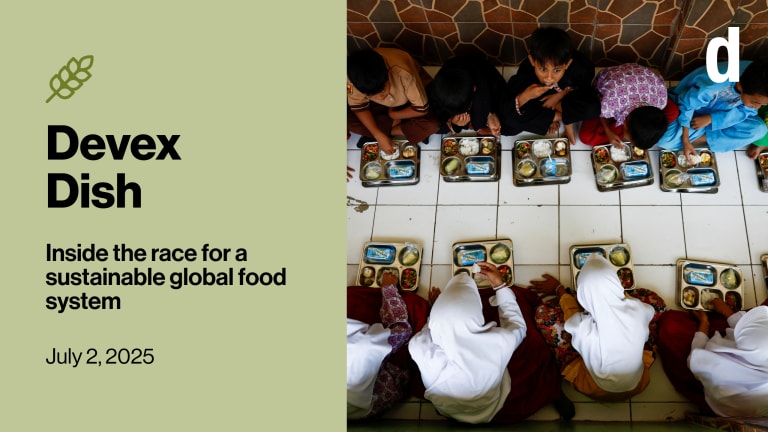
NEW YORK — Global hunger levels have decreased over the past two decades, but the slow and unequal pace of progress still puts the United Nations’ 2030 Sustainable Development Goal of zero hunger out of reach, according to the annual Global Hunger Index, released Wednesday.
While 14 countries have improved their hunger scores by 50 percent from 2000 to 2017, 52 countries still suffer from alarming, or extreme, levels of hunger, according to the index, which measures data in 119 countries.
Conflict is the unifying factor for most of the countries that continue to falter in the fight against both food insecurity and the ability to collect comprehensive data on hunger reduction and health, said Klaus von Grebmer, a consultant on the project, who also helped found the index 12 years ago.
“All of those countries have had, or are currently in the midst of, a conflict and this is the most severe factor I saw here,” von Grebmer told Devex. “You can have actual disasters and floods or droughts, but then, again, if there is good government at work, the country is more or less resilient. This is a situation where if you have conflicts, that is the number one [problem], or if you have bad governance, that is point number two.”
The Washington, D.C.-based International Food Policy Research Institute compiles the index, which aims to track food insecurity and hunger trends over time and raise awareness of failures and successes in hunger reduction. Governments and civil society often look to the index, which draws from U.N. data, as a key source of reference on hunger and health.
Top 3 takeaways from the Global Hunger Index: Africa edition
Tackling hunger and undernutrition in Africa has improved over the past decade, but challenges persists as many countries face "unacceptably high" hunger levels, according to this year's Global Hunger Index: Africa edition.
Eight countries — all but one located in Africa — are considered to suffer from “extremely alarming” or “alarming” hunger levels. These are the Central African Republic, Chad, Sierra, Leone, Madagascar, Zambia, Yemen, Sudan, and Liberia. And 13 more, including Syria, South Sudan, and the Democratic Republic of Congo, were found to have incomplete data. Nine of these places pose a “significant concern” that should not be underestimated, even though they lack formal GHI scores.
“Many of them are countries in conflict, so some of them just don’t have their act in order. Three years ago, we used to put those countries in gray — [but] we thought about it actually and said, ‘We are letting those get away with murder,’” von Grebmer said.
Parts of Nigeria, Somalia, South Sudan, and Yemen were all found to be at risk of famine in 2017; a collective 145 million people are in need of humanitarian assistance in these countries. This week, the U.N. announced that the Central Emergency Response Fund met its 2017 funding goal of $450 million. CERF’s funding target for next year will aim for an unprecedented $1 billion. Many major, protracted humanitarian crises still require ongoing funding, with Somalia’s $1 billion humanitarian response plan, for example, only about half fulfilled.
Overall, global hunger — and illness and death of young children resulting from hunger — has declined since 1992 by 27 percent, according to the 2017 GHI findings. The index considers four indicators: under 5 mortality rate, prevalence of wasting in children, prevalence of stunting in children, and proportion of undernourished people.
The global rate of children under age 5 who are stunted has decreased from 37.7 percent in 2000 to 27.8 percent today. The percentage of children dying under the age of 5 because of hunger has nearly halved, down from 8.2 percent to 4.7 percent, within this same timeframe.
China, Ukraine, Turkey, Brazil, and Peru are among the countries that have shown the most progress on reducing their GHI score. The Central African Republic, Venezuela, Mauritiana, and Sri Lanka have higher hunger scores today than they did in 2008.
The index’s analysis of subnational data reveals that even in some countries with improving levels of food access and nutrition, such as Honduras, child stunting levels are still high and above the regional average. A tailored approach to food insecurity in each country is likely necessary to reach the global zero hunger goal by 2030, the index suggests.
The index also recognizes gender inequality as the “axis of nutritional inequality,” as women and girls comprise 60 percent of the world’s hungry. And women’s lack of independence in society and their households can be closely linked to their children’s low birth weight and health.
“Most closely tied to hunger, perhaps, is poverty, the clearest manifestation of societal inequality,” the report reads.
Read more international development news online, and subscribe to The Development Newswire to receive the latest from the world’s leading donors and decision-makers — emailed to you free every business day.


